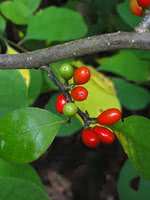Mon-Fri 9am - 5pm Mountain time
Black Elderberry vs Spicebush
Sambucus canadensis
Lindera benzoin
NOT AVAILABLE THIS SEASON - MIGHT RETURN
NOT AVAILABLE THIS SEASON - MIGHT RETURN
Black Elderberry is a deciduous shrub native to eastern North America. You can plant this shrub in moist areas and it will help stabilize your soil. You can also use it on rural properties anywhere you'd use a lilac.
Black Elderberries are considered to be partially self-pollinating. So while they will still produce some berries without cross-pollination, planting with another variety will increase yields. Consider planting with Ranch Elderberry or Bob Gordon Elderberry.
Warning: the seeds, stems, leaves, roots, and uncooked berries of the Black Elderberry are poisonous to humans when eaten in quantity. You should cook the berries to make them safe for human consumption.
The Spicebush is an unique ornamental shrub that blooms with vibrant yellow flowers and bright green foliage. The foliage goes from green to yellow in the autumn, adding fall interest to your garden.The plant is dioecious, meaning that you will need male and female plants in order to harvest it’s red berries. Berries are only produced on female plants. The berries themselves aren’t that sweet, and are mostly enjoyed by birds and other wildlife.
The Spicebush, also commonly known as Common Spicebush, Northern Spicebush, Wild Allspice, and Benjamin Bush, is named after its distinctive spicy-sweet fragrance that comes from the flowers.
Black Elderberry Quick Facts
Spicebush Quick Facts
Toxicity: leaves, stems, and uncooked berries are poisonous to humans

